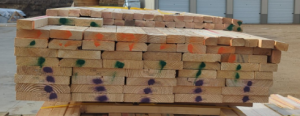Why isn’t a 2×4 truly 2” x 4”?
When Hansen Pole Buildings first began in 2002, owner J.A. Hansen did all of the drafting. As a lifetime Registered Nurse, Judy had the attention to detail it took to be an excellent drafter. In her “nursing world” everything was measured in exact numbers. If a patient needed 10 milligrams of a drug, they were administered exactly 10 milligrams. No more, no less, and right on schedule. You didn’t give the patient between 5 and 20 milligrams, somewhere between 8AM and noon!
This is where the challenge came in for Judy learning to draft…a 2 x 4 did not measure 2 inches by 4 inches! Not only that, once I patiently explained framing lumber and sizes, a 2×4 was not even held to an exact 1-1/2” by 3-1/2”, but had an “acceptable range” for size, I was afraid she’d walk right out the door and never come back!
Back in the olden days of cutting trees into framing lumber, a 2×4 did actually measure more or less two inches by four inches.

Eventually evolution created high production building and high production sawmills. High production builders demanded smooth surfaced lumber to work with, rather than the rough sawn lumber primitive mills had been cranking out. About the same time, dried lumber became popular for its dimensional stability and resistance to mold.
Running the formerly rough cut 2×4 through a planer (to create smooth surfaces) and the drying process created a finished piece of lumber which measured 1-5/8” x 3-5/8”.
In the late 1970’s today’s standard sized 1-1/2” x 3-1/2” dry 2×4 was created. Besides ½ inch being easier to measure than 5/8 inch, we can only assume some brilliant bean counter in a sawmill office determined this would allow the recovery of one extra 2×4 board out of every log!
There are those naysayers who would attribute this “smaller” piece of framing lumber to less longevity in modern structures. However, all engineering calculations are based upon the actual dry size of the material being utilized. Yes, the sizes are somewhat confusing, but they do work.
To receive more pole building tips and advice subscribe to the pole barn guru blog!






